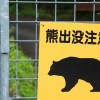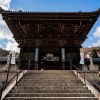From fashion to extracurricular activities, the lives of an American colleges students are an ocean apart from their counterparts in Japan.
Most of the English-language RocketNews24 team spent a portion of our school days in Japan, but our Japanese-language sister site can also count a few writers with study abroad experience. We recently picked the brain of one of our Japanese writers who spent two years of college in Osaka before crossing the Pacific to the United States and finishing his higher education in Wisconsin. Below, in his words, is his personal take on the differences he experienced between college life in Japan and America.
1. Fashion
In Japan, almost all junior and senior high school students have to wear uniforms. Most people don’t get to choose what they wear every day until they get into college, and in response to that new freedom, many of them start spending a lot of money on clothes and accessories. So regardless of whether the end result is fashionable or not, many of the people you’ll see on a Japanese college campus have put a lot of thought into what they’re wearing.
On the other hand, at American universities it seems like the emphasis is on comfort and practicality. Every day I saw plenty of my classmates wearing the sweatshirts and T-shirts they sold in the student store. Because of this gap in the fashion environment, when I wore the same outfits I had when I was in Japan, people often mistakenly assumed I was gay.
2. Extracurricular club activities
This might be something that’s unique to Japan, but Japanese schools have two classes of extracurricular clubs: bu/teams and sakuru/circles.
Compared to the bu, the circles aren’t as serious-minded, and their focus is more on everyone just having fun as a group. For example, in one of the tennis circles at my school in Japan, the members only got together to practice two or three times a week. The rest of the time, they’d just go drinking together.
Because circles have such a strong social aspect, for Japanese students they’re the primary place where they make new friends, and the circle you join becomes a group with a very big influences on the rhythm and patterns of your lifestyle.
At American colleges, though, the clubs and sports teams are closer to Japanese bu than circles. The members have to practice and train hard every day, so very few students make the commitment of joining them, and instead it felt like more of them were focused on their studies.
3. Academic pressure
To get into a Japanese college, you have to pass rigorous, competitive entrance exams, which high school students spend a huge amount of time studying for. But once you get accepted by a college, you’re on easy street!
In general, as long as you attend class, you can get units in a Japanese college. Some courses don’t even require you to show up, and instead just ask you to write a report and turn it in at the end of the semester to pass the class. As a result a lot of students ditch class, and spend their time drinking with their friends from their circle or having marathon video gaming sessions.
But in America, every day we had to study our butts off! In my classes, I had a report to write every other week, on top of reading the textbook and other assigned materials, plus getting my term papers ready to submit. When finals time rolled around, sometimes the library was so packed with students studying that there was no place to sit. One of my American friends knows how much Japanese high school kids have to study for entrance exams, and he told me “You could have had it easy if you stayed in Japan for college! You were crazy to come here.”
4. Living arrangements
Many Japanese college students live alone, and almost all of my friends when I was going to school in Japan lived in their own apartment. As a matter of fact, in Japan there’s an image that getting into college means you can have your own place, which is a dream that keeps many high school students going when they’re getting ready for entrance exams. Of course, it turns out some of them can’t cook for themselves or keep their apartments clean, and their lifestyles gradually deteriorate.
In contrast, most of the people at my American college lived in the dorms, together with a roommate. It’s a nice system if you’re both on the same wavelength, but if you’re not then it’s terrible!
Thankfully my roommates and I got along fine, but some of the people I knew complained about their roommates sneaking their boyfriend or girlfriend into their room or playing music that they hated, and a few of them even asked to switch rooms.
5. Class participation
In Japanese colleges, the students don’t really talk during the lecture. Actually, that goes for Japanese elementary, middle, and high schools too. The teacher does the talking, and the students just listen, without asking questions or debating what’s being said.
Even in the rare case that a Japanese class is set up in the format of a debate, the students won’t give their opinion until the teacher calls on them specifically. And in the event that Japanese students do want to ask the teacher something, they wait until after class and approach him individually, maybe in his office.
Things are completely different in the U.S. The students are always ready to speak up. If they don’t understand anything, they ask about it right away, and if there are conflicting opinions, everyone joins in on the debate.
For someone like me, who’d grown up in the Japanese education system, it was a shock, and getting used to that discussion-centric style took a very long time. Looking back, I think it’s safe to call the Japanese lesson style a passive one, and the American one an active one, but I learned a lot from each.

 One Direction’s Harry Styles imports Japanese to the United States
One Direction’s Harry Styles imports Japanese to the United States Teacher says Japanese schools’ mandatory extracurricular activity rules don’t benefit students
Teacher says Japanese schools’ mandatory extracurricular activity rules don’t benefit students Don’t like trigonometry? Then you’re just like Hitler, says Japanese high school English teacher
Don’t like trigonometry? Then you’re just like Hitler, says Japanese high school English teacher Not everyone hates school uniforms: Japanese Twitter shows us why
Not everyone hates school uniforms: Japanese Twitter shows us why Japanese university says your girlfriend might dump you, other harsh truths in recruiting ad
Japanese university says your girlfriend might dump you, other harsh truths in recruiting ad Foreigner’s request for help in Tokyo makes us sad for the state of society
Foreigner’s request for help in Tokyo makes us sad for the state of society McDonald’s Japan’s new pancake pie is a taste sensation
McDonald’s Japan’s new pancake pie is a taste sensation Studio Ghibli unveils massive T-shirt collection featuring top anime movie characters
Studio Ghibli unveils massive T-shirt collection featuring top anime movie characters Bad tourist manners at Mt Fuji Lawson photo spot prompts Japanese town to block view with screens
Bad tourist manners at Mt Fuji Lawson photo spot prompts Japanese town to block view with screens FUK COFFEE?!? Japanese cafe has a perfectly innocent reason for its startling-looking name
FUK COFFEE?!? Japanese cafe has a perfectly innocent reason for its startling-looking name Two things to do, and two things not to do, when leaving a traditional Japanese inn
Two things to do, and two things not to do, when leaving a traditional Japanese inn One of Japan’s oldest castles now lets travelers spend night on the grounds, drink in its keep
One of Japan’s oldest castles now lets travelers spend night on the grounds, drink in its keep Bear attacks car in Japan, breaks windshield with its paw【Video】
Bear attacks car in Japan, breaks windshield with its paw【Video】 A visit to the ordinarily forbidden hall of Nara’s Hasedera Temple【Photos】
A visit to the ordinarily forbidden hall of Nara’s Hasedera Temple【Photos】 Who wins in a battle of McDonald’s and Komeda Coffee’s chicken tatsuta burgers?【Taste test】
Who wins in a battle of McDonald’s and Komeda Coffee’s chicken tatsuta burgers?【Taste test】 Japanese ramen restaurants under pressure from new yen banknotes
Japanese ramen restaurants under pressure from new yen banknotes Red light district sushi restaurant in Tokyo shows us just how wrong we were about it
Red light district sushi restaurant in Tokyo shows us just how wrong we were about it McDonald’s new Happy Meals offer up cute and practical Sanrio lifestyle goods
McDonald’s new Happy Meals offer up cute and practical Sanrio lifestyle goods Tokyo Tsukiji fish market site to be redeveloped with 50,000-seat stadium, hotel, shopping center
Tokyo Tsukiji fish market site to be redeveloped with 50,000-seat stadium, hotel, shopping center Japanese city loses residents’ personal data, which was on paper being transported on a windy day
Japanese city loses residents’ personal data, which was on paper being transported on a windy day Beautiful Red and Blue Star luxury trains set to be Japan’s new Hokkaido travel stars
Beautiful Red and Blue Star luxury trains set to be Japan’s new Hokkaido travel stars Ghibli Park now selling “Grilled Frogs” from food cart in Valley of Witches
Ghibli Park now selling “Grilled Frogs” from food cart in Valley of Witches New definition of “Japanese whiskey” goes into effect to prevent fakes from fooling overseas buyers
New definition of “Japanese whiskey” goes into effect to prevent fakes from fooling overseas buyers Our Japanese reporter visits Costco in the U.S., finds super American and very Japanese things
Our Japanese reporter visits Costco in the U.S., finds super American and very Japanese things All-you-can-drink Starbucks and amazing views part of Tokyo’s new 170 meter-high sky lounge
All-you-can-drink Starbucks and amazing views part of Tokyo’s new 170 meter-high sky lounge More foreign tourists than ever before in history visited Japan last month
More foreign tourists than ever before in history visited Japan last month New Pokémon cakes let you eat your way through Pikachu and all the Eevee evolutions
New Pokémon cakes let you eat your way through Pikachu and all the Eevee evolutions Disney princesses get official manga makeovers for Manga Princess Cafe opening in Tokyo
Disney princesses get official manga makeovers for Manga Princess Cafe opening in Tokyo We try out “Chan Ramen”, an underground type of ramen popular in the ramen community
We try out “Chan Ramen”, an underground type of ramen popular in the ramen community Sales of Japan’s most convenient train ticket/shopping payment cards suspended indefinitely
Sales of Japan’s most convenient train ticket/shopping payment cards suspended indefinitely Sold-out Studio Ghibli desktop humidifiers are back so Totoro can help you through the dry season
Sold-out Studio Ghibli desktop humidifiers are back so Totoro can help you through the dry season Japanese government to make first change to romanization spelling rules since the 1950s
Japanese government to make first change to romanization spelling rules since the 1950s Ghibli founders Toshio Suzuki and Hayao Miyazaki contribute to Japanese whisky Totoro label design
Ghibli founders Toshio Suzuki and Hayao Miyazaki contribute to Japanese whisky Totoro label design Doraemon found buried at sea as scene from 1993 anime becomes real life【Photos】
Doraemon found buried at sea as scene from 1993 anime becomes real life【Photos】 Tokyo’s most famous Starbucks is closed
Tokyo’s most famous Starbucks is closed One Piece characters’ nationalities revealed, but fans have mixed opinions
One Piece characters’ nationalities revealed, but fans have mixed opinions We asked a Uniqlo employee what four things we should buy and their suggestions didn’t disappoint
We asked a Uniqlo employee what four things we should buy and their suggestions didn’t disappoint University of Tokyo students can show off school pride with new jacket boasting ID display pocket
University of Tokyo students can show off school pride with new jacket boasting ID display pocket Japanese college students share four ways anime high school is different from real high school
Japanese college students share four ways anime high school is different from real high school “Students are only allowed three sneezes in class” Japanese people share their worst school rules
“Students are only allowed three sneezes in class” Japanese people share their worst school rules ALT in Japan asked to remove earrings by Board of Education
ALT in Japan asked to remove earrings by Board of Education U.S. university has “Reading and Writing About Magical Girls” as introductory English course
U.S. university has “Reading and Writing About Magical Girls” as introductory English course Educator offers advice for Japanese schoolgirls who get asked out by their teachers
Educator offers advice for Japanese schoolgirls who get asked out by their teachers What’s wrong with English education in Japan? Pull up a chair…
What’s wrong with English education in Japan? Pull up a chair… Is Japan overworking its teachers? One exhausted educator says, “YES!”
Is Japan overworking its teachers? One exhausted educator says, “YES!” Japanese government promises reduced teacher responsibilities, right to refuse club supervision
Japanese government promises reduced teacher responsibilities, right to refuse club supervision Literally wipe out your chances of academic failure with prep school’s unique erasers
Literally wipe out your chances of academic failure with prep school’s unique erasers Line up in the hall, open your shirts, show your bras – Real instructions from one Japanese school
Line up in the hall, open your shirts, show your bras – Real instructions from one Japanese school “Hate summer homework, kids? We’ll do it for you!” A disturbingly booming business in Japan
“Hate summer homework, kids? We’ll do it for you!” A disturbingly booming business in Japan Petition to allow students to choose what they wear to school gathers almost 19,000 signatures
Petition to allow students to choose what they wear to school gathers almost 19,000 signatures Teacher’s heartwarming message helps student pursue art dream
Teacher’s heartwarming message helps student pursue art dream Can you handle the heat? Japan’s one and only Curry College now enrolling new students
Can you handle the heat? Japan’s one and only Curry College now enrolling new students Japanese teacher simply asks to be treated like a human being
Japanese teacher simply asks to be treated like a human being Former schoolgirl sues Tokyo high school that made her drop out for breaking no-dating rule
Former schoolgirl sues Tokyo high school that made her drop out for breaking no-dating rule
Leave a Reply